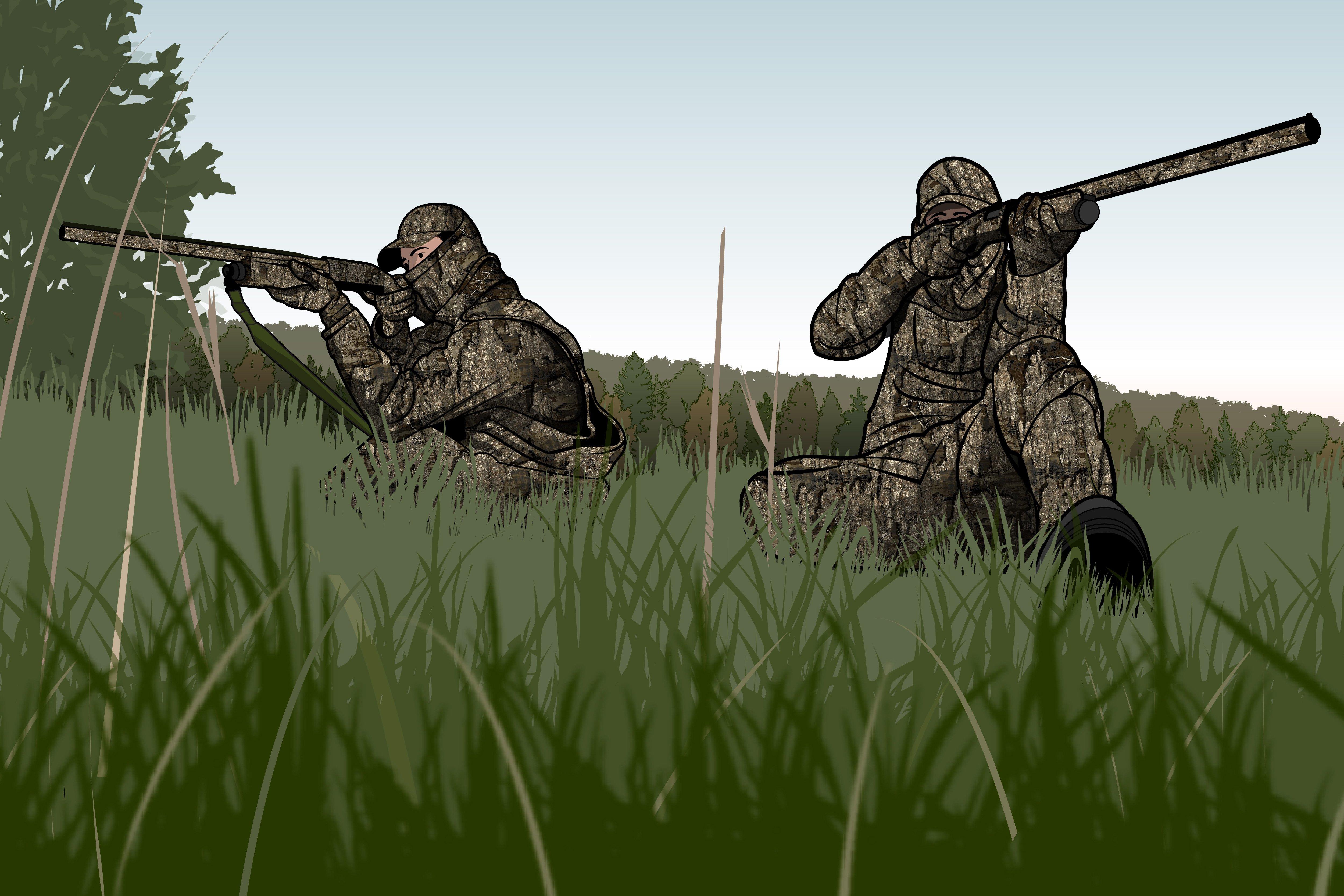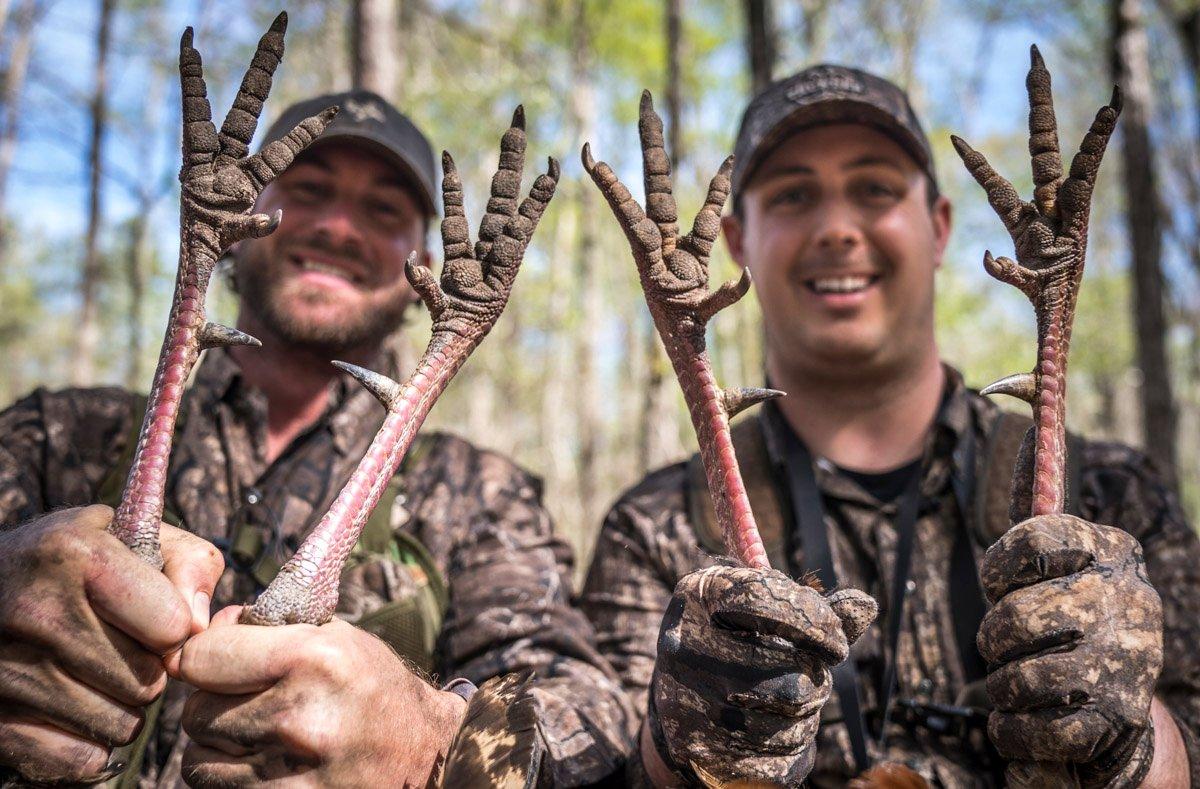Two turkeys come in, and two guns are waiting. Follow this advice to fill two tags
It was one of those hunts where everything was coming together. After a hot, windy morning with almost no gobbling, my wife, Cheryl, and I finally struck up a pair of willing longbeards. They were just over the rise and out of sight. We had them on a string, each gobble closer than the one before. I'd stopped calling and eased my gun up, knowing both birds would appear in range any second now.
Calling in two birds is pretty common. Tagging them both isn't. In addition to some luck, doubling on longbeards takes planning. Whether you're hunting with a buddy, spouse, child or even that guy from the office that you normally can't stand but who has a really good turkey spot, here's how to up your odds this season.
Safety First
With two shooters and two birds, things can get intense in a hurry. Make a game plan as soon as you sit down. Set up side-by-side, as close together as possible, so that you have the same view and can clearly see one another. Pay attention to the areas where you can both shoot safely, and agree not to shoot unless both birds are in the safe zone. Never, ever set up with one hunter behind the other if you both plan to shoot.
Plan Early
Do you shoot on 3? Or was it 1,2,3, Shoot? The time to decide isn't when a pair of sharp-eyed gobblers are in range. Come up with a plan before the birds ever get there. And don't be like that guy in the duck blind who shoots first, and then hollers Take 'em!
For seasoned turkey pros who have hunted together for years, the signal might not be vocal at all. It might just be a quick dip of the hat bill. That's another reason why it's important to set up where you can see one another. Phillip Culpepper, host of Spring Thunder on Realtree 365, likes to set up shoulder-to-shoulder if possible. I like to be able to communicate between hunters so both can be on the same page at the time of the shot. Of course, your buddy may be like mine, shoot first then look over and ask 'Why didn't you shoot too?' Culpepper laughs.
Decide in advance who is going to shoot which bird, on which side.
Culpepper prefers hunting field edges when he can, and he says getting tight to birds roosted on a field edge is the perfect scenario for pulling off a double. Just about every double I've ever been a part of happened in a field, he says. It's just a lot easier to double up in the open than in the woods, where you have to shoot around trees and stuff.
Use a Decoy
When it comes to doubles, Culpepper prefers to use a decoy where legal. A jake decoy will often hold a mature bird's attention, keeping it off the hunters and giving the hunters just a little extra time to get shots, he says. Sometimes just an extra second or two is all it takes.
Hide Well
Turkey hunters know how hard it is to fool a gobbler's eyesight when there is just one person and one bird to worry about. Add a second hunter and a second set of turkey eyes, and things get exponentially tougher.
Take care that both hunters are well hidden. Head-to-toe Realtree camo helps, and so does using a big tree and any available cover to break up your outline. Even if one hunter is completely hidden, you aren't going to get a shot if the other is sitting out in the wide open.
Blinds can really stack the odds in your favor. A good pop-up like the Rhino 150 easily hides a pair of hunters, giving you plenty of time to position for a clear shot, while covering up movement you could never get away with out in the open. It's particularly useful when hunting with new or young hunters who might need a bit of extra coaching to get into position on a bird.
Be Decisive
That pair of birds I told you about earlier? They played the game perfectly. The bird on my side came strutting up to our hen decoy, set just 15 yards away. He belted out a gobble, went into full strut and drummed so loudly I could feel the vibration in my chest. The red dot of my scope hovered over his head.
The bird on my wife's side wasn't quite as sure about the situation. He hung up at 30 yards, well within range of her 20-gauge Federal TSS loads, but he kept his head down in the tall grass. When my bird turned straight away in full strut, I quietly yelped to get the second bird's attention.
When the bright red head of Cheryl's bird appeared above the cover, I whispered, One, two, three, shoot. But I didn't shoot. I took a second to watch her bird fall, and then I swung my attention back to what I expected to be a standing longbeard.
He wasn't. In that split second of hesitation on my part, my gobbler had launched himself into the air with all the fury of a flushing grouse. I was so shocked to see him 10 feet off the ground that I hesitated again before attempting to find his head in my red dot. By the time I had everything lined up, he was 30 yards away and darting between the cedars that lined the field edge. I'm pretty sure he laughed as I pulled the trigger, as certain as I was that he was safe.
I tell that story to say this: Things can happen fast when you're dealing with wild turkeys. If you're trying to double, pay attention to the bird you plan to shoot. When you get the chance to pull the trigger, take it.
Know How to Laugh it Off
Even with the best-laid plans, killing a mature longbeard is a tough proposition. Calling in two of them and bagging them both is even tougher. Chances are it will fall apart more often than it works out. Maybe one of you ends up with a bird — or maybe no one does. Either way, it's still going to be a good time. Laugh at the failed attempts, and give credit to the boss gobblers that give you the slip. Then start making plans to get back on them later.
That later may be a few days, or it might be a few minutes. I've been on a lot of hunts where we take one bird, and the other either runs over and flogs the downed bird or runs off a little and stops. If you don't immediately jump up and whoop and holler, a lot of times you can call the second bird back in for another round, Culpepper says.
Does it still count as a double if a few minutes pass between shots? It sure does in my book.
Watch Realtree 365's Spring Thunder turkey hunting videos here.









